Enriching Mental Health Mobile Assessment and Intervention with Situation Awareness †
Abstract
:1. Introduction
- (1)
- How does one accurately assess the patient’s mental status by minimizing the recall bias and, at the same time, not being excessively intrusive? Recall bias is a systematic error due to differences in the accuracy or completeness of the recall of past events or experiences. The memory bias alters recalled memories of past events, introducing significant differences to what actually happened to the patient. This poses problems in a psychological treatment where questions are posed by the mental health professional (e.g., psychologist or psychiatrist) to the patient several days later.
- (2)
- How does one accurately identify situations experienced by the patient in a time period? Having a better insight into the patient’s daily routine, a mental health professional may be able to discuss the causes and effects of depressive symptoms (e.g., “if they are spending too long at work”; “if they are sleeping for most part of the day”), thus improving the effect of therapy. Moreover, the professional can correlate situations experienced by patients with the record of their assessments, thus trying to infer which situations have a positive or negative impact on the patient’s state of mind.
2. Preliminaries and Related Research
2.1. The MoodBuster Ecological Momentary Assessment and Intervention
2.2. Related Work
3. The Situation Inference Engine of the SituMan
3.1. Reasons for Using Fuzzy Logic
- (1)
- Fuzzy logic uses rules that, on a high level, can be defined by non-expert users. In SituMan, these rules consist of information on location, time and activities. Hence, by defining a situation or context as a combination of location, time and certain activities, users develop rules for the triggering of EMAs that are transparent and provide end-users with the knowledge when rules will be triggered. This in turn leads to the ability to tailor interventions easily and to a feeling of empowerment in users;
- (2)
- There is no need for a training phase as would be required if any supervised machine learning technique were used, because users define their situations using specifications, such as fuzzy rules (i.e., users perform the role of experts in the system). The use of supervised machine learning for identifying situations would require that each user goes through an individual training phase that could be very time consuming and that could depend on the user providing constant feedback. This individual training phase is required because the context data used to define a given situation experienced by different users are typically different. For example, the situation “working” experienced by Alice is different from that experienced by Bob. In addition, changes in the user’s daily routine would require a new training phase in order to learn the new situations experienced in that new routine.
- (1)
- Fuzzy rule-based systems use IF-THEN rules, a deductive form to express inference [39]. This fuzzy inference is the application of decision making structures, called fuzzy rules, using fuzzy logic values (i.e., linguistic variables) and logical connectives. Linguistic variables have values that are not numbers, but words or sentences expressed in a natural or artificial language [40], and these variables can represent imprecise and qualitative human knowledge and are used to label fuzzy sets [38]. Therefore, fuzzy logic provides a notation to represent the inference process using rules that can be easily understood. In other words, fuzzy rules provide a language that allows the user to express contextual information that can represent values as terms instead of using crisp sets, and these terms can be represented in friendly user interfaces.
- (2)
- As described in the literature about the quality of context [41], contextual information obtained from sensors embedded in mobile devices may not be of high quality, such as precision and accuracy. For example, geographic coordinates obtained from a GPS can be imprecise. To cope with this issue, fuzzy logic enables approximate reasoning to conclusions ranging from false to true, i.e., partly true (or partly false).
- (3)
- Situations correspond to a reality that people perceive, live and reason about [42]. This human reasoning is naturally ambiguous, imprecise and qualitative. To cope with these issues, fuzzy logic has been used to computationally model human reasoning [34], such as a real-life daily routine situation. Such endeavours have shown that fuzzy inference systems enable human specialists in a domain to map their experience and their decision making process to computer systems using fuzzy rules.
- (4)
- Fuzzy logic does not require much computing power from the mobile device to perform the inference process, thus avoiding a high demand on battery power or communication with a server/cloud to offload computations. Hence, the identification process of the current user situation does not depend on communication channel conditions or server/cloud availability. This is important because the current user situation is required in real time.
3.2. Conceptual Model of the Engine
3.3. Adapted Fuzzy Inference Process
3.4. Situation Examples
- (1)
- if the patient is located at home and the time of day is in the morning and it is a weekend day and the patient is still, then the situation is relaxing time;
- (2)
- if the patient is located near his/her workplace and the time of day is in the morning or afternoon and it is a weekday (Monday to Friday) and the patient is still or walking, then the situation is working;
- (3)
- if the patient is located near the beach and the time of day is at night and it is a weekday (Monday to Friday) and the patient is walking or running, then the situation is physical activity.
- Location: The user registers a point on a map and determines the linguistic variable “near”. For this example, we will assume a point at his/her workplace. At the time of inference, the engine: (1) checks the current patient location; (2) checks the coordinates recorded in the situation (i.e., “user’s workplace”); and (3) then calculates the Euclidean distance between these points to set the input value for this context information.
- Time: The user chooses “weekday” in the day of week and checks “morning” and “afternoon” in time of day. At the time of inference, the engine: (1) checks the current time from the mobile device clock; (2) formats the data to numerical information used in the fuzzy sets regarding time; and (3) sets the input values for this context information.
- Activity: The user specifies “walking” and “running” and, at the time of inference, the engine: (1) checks the current activities being performed by the user; (2) gets and normalizes the probability values from the specific activities “walking” and “running”; and (3) sets the input value for activity information from the sum of the correspondent probability values.
- Location: input value from 0 to 800 m from the point registered in the map by the user and the location where the user is at the inferencing time;
- Day of the week: from 1.3 to 5.7, where 24 h are represented in the range from 0 to 1;
- Time of day: from 6 to 12, or from 14 to 17, where 60 min are represented in a scale from 0 to 1;
- Activity: one.
4. Computational Implementation and Features
Proposed Tools for Mental Disorder Treatments
5. Experimental Evaluations
5.1. Experiment 1: User Satisfaction
5.1.1. Methodology and Participants
5.1.2. Results
5.2. Experiment 2: Accuracy of Situation Identification
5.2.1. Methodology and Participants
5.2.2. Results
5.3. Discussion
6. Conclusions
Acknowledgments
Author Contributions
Conflicts of Interest
Abbreviations
| AIDL | Android Interface Definition Language |
| API | Application Programming Interface |
| EMA | Ecological Momentary Assessment |
| EMI | Ecological Momentary Intervention |
| EMA/I | Ecological Momentary Assessment and Intervention |
| FCL | Fuzzy Control Language |
| GUI | Graphical User Interface |
| INESC TEC | Institute for Systems Engineering and Computers, Technology and Science |
| ISMAI | University Institute of Maia |
| SituMan | Situation Manager |
References
- Dey, A.K. Understanding and Using Context. Pers. Ubiquitous Comput. 2001, 5, 4–7. [Google Scholar] [CrossRef]
- Kumar, S.; Nilsen, W.; Pavel, M.; Srivastava, M. Mobile Health: Revolutionizing Healthcare Through Transdisciplinary Research. Computer 2013, 46, 28–35. [Google Scholar] [CrossRef]
- Gravenhorst, F.; Muaremi, A.; Bardram, J.; Grünerbl, A.; Mayora, O.; Wurzer, G.; Frost, M.; Osmani, V.; Arnrich, B.; Lukowicz, P.; et al. Mobile Phones As Medical Devices in Mental Disorder Treatment: An Overview. Pers. Ubiquitous Comput. 2015, 19, 335–353. [Google Scholar] [CrossRef] [Green Version]
- Teles, A.S.; Rocha, A.; Silva, F.J.; Lopes, J.C.; O’Sullivan, D.; de Ven, P.V.; Endler, M. Towards Situation-aware Mobile Applications in Mental Health. In Proceedings of the IEEE 29th International Symposium on Computer-Based Medical Systems (CBMS’16), Dublin, Ireland, 20–23 June 2016; pp. 349–354.
- Anagnostopoulos, C.B.; Ntarladimas, Y.; Hadjiefthymiades, S. Situational Computing: An Innovative Architecture with Imprecise Reasoning. J. Syst. Softw. 2007, 80, 1993–2014. [Google Scholar] [CrossRef]
- Anagnostopoulos, C.; Hadjiefthymiades, S. Enhancing Situation-Aware Systems through Imprecise Reasoning. IEEE Trans. Mob. Comput. 2008, 7, 1153–1168. [Google Scholar] [CrossRef]
- Anagnostopoulos, C.; Hadjiefthymiades, S. Advanced fuzzy inference engines in situation aware computing. Fuzzy Sets Syst. 2010, 161, 498–521. [Google Scholar] [CrossRef]
- Van de Ven, P.; Henriques, M.R.; Hoogendoorn, M.; Klein, M.; McGovern, E.; Nelson, J.; Silva, H.; Tousset, E. A Mobile System for Treatment of Depression. In Proceedings of the International Joint Conference on Biomedical Engineering Systems and Technologies (BIOSTEC’12), Vilamoura, Portugal, 1–4 February 2012.
- Shiffman, S.; Stone, A.A.; Hufford, M.R. Ecological Momentary Assessment. Ann. Rev. Clin. Psychol. 2008, 4, 1–32. [Google Scholar] [CrossRef]
- Heron, K.E.; Smyth, J.M. Ecological momentary interventions: Incorporating mobile technology into psychosocial and health behaviour treatments. Br. J. Health Psychol. 2010, 15, 1–39. [Google Scholar] [CrossRef] [PubMed]
- Rocha, A.; Henriques, M.R.; Correia Lopes, J.; Camacho, R.; Klein, M.; Modena, G.; Van de Ven, P.; McGovern, E.; Tousset, E.; Gauthier, T.; et al. ICT4Depression: Service oriented architecture applied to the treatment of depression. In Proceedings of the IEEE 25th International Symposium on Computer-Based Medical Systems (CBMS’12), Rome, Italy, 20–22 June 2012.
- Kleiboer, A.; Smit, J.; Bosmans, J.; Ruwaard, J.; Andersson, G.; Topooco, N.; Berger, T.; Krieger, T.; Botella, C.; Baños, R.; et al. European COMPARative Effectiveness research on blended Depression treatment versus treatment-as-usual (E-COMPARED): Study protocol for a randomized controlled, non-inferiority trial in eight European countries. Trials 2016, 17, 387. [Google Scholar] [CrossRef] [PubMed]
- Alemdar, H.; Ersoy, C. Wireless Sensor Networks for Healthcare: A Survey. Comput. Netw. 2010, 54, 2688–2710. [Google Scholar] [CrossRef]
- Shoaib, M.; Bosch, S.; Incel, O.D.; Scholten, H.; Havinga, P.J. A Survey of Online Activity Recognition Using Mobile Phones. Sensors 2015, 15, 2059–2085. [Google Scholar] [CrossRef] [PubMed]
- Del Rosario, M.B.; Lovell, N. Tracking the Evolution of Smartphone Sensing for Monitoring Human Movement. Sensors 2015, 15, 18901–18933. [Google Scholar] [CrossRef] [PubMed]
- Medina, J.; Ruiz-Lozano, M.D.; Delgado, M.; Vila, A. A Fuzzy Temporal Rule-based System for Handling the Nursing Process on Mobile Devices. Expert Syst. Appl. 2012, 39, 10479–10488. [Google Scholar] [CrossRef]
- Olaru, A.; Florea, A.M. Context graphs as an efficient and user-friendly method of describing and recognizing a situation in AAL. Sensors 2014, 14, 11110–11134. [Google Scholar] [CrossRef] [PubMed]
- Canzian, L.; Musolesi, M. Trajectories of Depression: Unobtrusive Monitoring of Depressive States by Means of Smartphone Mobility Traces Analysis. In Proceedings of the 2015 ACM International Joint Conference on Pervasive and Ubiquitous Computing (UbiComp’15), Osaka, Japan, 7–11 September 2015; pp. 1293–1304.
- Reid, S.; Kauer, S.; Dudgeon, P.; Sanci, L.; Shrier, L.; Patton, G. A mobile phone program to track young people’s experiences of mood, stress and coping. Soc. Psychiatry Psychiatr. Epidemiol. 2009, 44, 501–507. [Google Scholar] [CrossRef] [PubMed]
- Morris, M.E.; Kathawala, Q.; Leen, T.K.; Gorenstein, E.E.; Guilak, F.; Labhard, M.; Deleeuw, W. Mobile Therapy: Case Study Evaluations of a Cell Phone Application for Emotional Self-Awareness. J. Med. Internet Res. 2010, 12, e10. [Google Scholar] [CrossRef] [PubMed]
- Ben-Zeev, D.; Kaiser, S.M.; Brenner, C.J.; Begale, M.; Duffecy, J.; Mohr, D.C. Development and usability testing of FOCUS: A smartphone system for self-management of schizophrenia. Psychiatr. Rehabil. J. 2013, 36, 289–296. [Google Scholar] [CrossRef] [PubMed]
- Kasckow, J.; Zickmund, S.; Rotondi, A.; Mrkva, A.; Gurklis, J.; Chinman, M.; Fox, L.; Loganathan, M.; Hanusa, B.; Haas, G. Development of Telehealth Dialogues for Monitoring Suicidal Patients with Schizophrenia: Consumer Feedback. Community Ment. Health J. 2013, 50, 339–342. [Google Scholar] [CrossRef] [PubMed]
- Dickerson, R.F.; Gorlin, E.I.; Stankovic, J.A. Empath: A Continuous Remote Emotional Health Monitoring System for Depressive Illness. In Proceedings of the 2nd Conference on Wireless Health (WH’11), La Jolla, CA, USA, 10–13 October 2011; pp. 1–10.
- Dickerson, R.F.; Hoque, E.; Emi, I.A.; Stankovic, J.A. Empath2: A Flexible Web and Cloud-based Home Health Care Monitoring System. In Proceedings of the 8th ACM International Conference on PErvasive Technologies Related to Assistive Environments (PETRA’15), Corfu, Greece, 1–3 July 2015.
- Burns, M.N.; Begale, M.; Duffecy, J.; Gergle, D.; Karr, C.J.; Giangrande, E.; Mohr, D.C. Harnessing Context Sensing to Develop a Mobile Intervention for Depression. J. Med. Internet Res. 2011, 13, e55. [Google Scholar] [CrossRef] [PubMed]
- Puiatti, A.; Mudda, S.; Giordano, S.; Mayora, O. Smartphone-centred wearable sensors network for monitoring patients with bipolar disorder. In Proceedings of the Annual International Conference of the IEEE Engineering in Medicine and Biology Society (EMBC), Boston, MA, USA, 30 August–3 September 2011; pp. 3644–3647.
- Frost, M.; Doryab, A.; Faurholt-Jepsen, M.; Kessing, L.V.; Bardram, J.E. Supporting Disease Insight Through Data Analysis: Refinements of the Monarca Self-assessment System. In Proceedings of the 2013 ACM International Joint Conference on Pervasive and Ubiquitous Computing (UbiComp’13), Zurich, Switzerland, 8–12 September 2013; pp. 133–142.
- Bardram, J.E.; Frost, M.; Tuxen, N.; Faurholt-Jepsen, M.; Kessing, L.V. Designing Context-aware Cognitive Behavioral Therapy for Unipolar and Bipolar Disorders. In Proceedings of the 2016 ACM International Joint Conference on Pervasive and Ubiquitous Computing: Adjunct (UbiComp ’16), Heidelberg, Germany, 12–16 September 2016; pp. 1162–1170.
- Lu, H.; Frauendorfer, D.; Rabbi, M.; Mast, M.S.; Chittaranjan, G.T.; Campbell, A.T.; Gatica-Perez, D.; Choudhury, T. StressSense: Detecting Stress in Unconstrained Acoustic Environments Using Smartphones. In Proceedings of the 2012 ACM Conference on Ubiquitous Computing (UbiComp’12), Pittsburgh, PA, USA, 5–8 September 2012; pp. 351–360.
- Voida, S.; Matthews, M.; Abdullah, S.; Xi, M.C.; Green, M.; Jang, W.J.; Hu, D.; Weinrich, J.; Patil, P.; Rabbi, M.; et al. MoodRhythm: Tracking and Supporting Daily Rhythms. In Proceedings of the 2013 ACM Conference on Pervasive and Ubiquitous Computing Adjunct Publication (UbiComp’13 Adjunct), Zurich, Switzerland, 8–12 September 2013; pp. 67–70.
- Rachuri, K.K.; Musolesi, M.; Mascolo, C.; Rentfrow, P.J.; Longworth, C.; Aucinas, A. EmotionSense: A Mobile Phones Based Adaptive Platform for Experimental Social Psychology Research. In Proceedings of the 12th ACM International Conference on Ubiquitous Computing (UbiComp’10), Copenhagen, Denmark, 26–29 September 2010; pp. 281–290.
- Lane, N.D.; Lin, M.; Mohammod, M.; Yang, X.; Lu, H.; Cardone, G.; Ali, S.; Doryab, A.; Berke, E.; Campbell, A.T.; et al. BeWell: Sensing Sleep, Physical Activities and Social Interactions to Promote Wellbeing. J. Mob. Netw. Appl. 2014, 19, 345–359. [Google Scholar] [CrossRef]
- Wang, R.; Chen, F.; Chen, Z.; Li, T.; Harari, G.; Tignor, S.; Zhou, X.; Ben-Zeev, D.; Campbell, A.T. StudentLife: Assessing Mental Health, Academic Performance and Behavioral Trends of College Students Using Smartphones. In Proceedings of the 2014 ACM International Joint Conference on Pervasive and Ubiquitous Computing (UbiComp’14), Seattle, WA, USA, 13–17 September 2014; pp. 3–14.
- Zadeh, L.A. Fuzzy logic = computing with words. IEEE Trans. Fuzzy Syst. 1996, 4, 103–111. [Google Scholar] [CrossRef]
- Zadeh, L. Fuzzy sets. Inform. Control 1965, 8, 338–353. [Google Scholar] [CrossRef]
- Bettini, C.; Brdiczka, O.; Henricksen, K.; Indulska, J.; Nicklas, D.; Ranganathan, A.; Riboni, D. A Survey of Context Modelling and Reasoning Techniques. Pervasive Mob. Comput. 2010, 6, 161–180. [Google Scholar] [CrossRef]
- Ye, J.; Dobson, S.; McKeever, S. Situation Identification Techniques in Pervasive Computing: A Review. Pervasive Mob. Comput. 2012, 8, 36–66. [Google Scholar] [CrossRef]
- Ross, T.J. Fuzzy Logic with Engineering Applications; Wiley: New York, NY, USA, 2010. [Google Scholar]
- Pedrycz, W.; Gomide, F. Fuzzy Systems Engineering: Toward Human-Centric Computing; Wiley-IEEE Press: New York, NY, USA, 2007. [Google Scholar]
- Zadeh, L.A. The concept of a linguistic variable and its application to approximate reasoning—I. Inform. Sci. 1975, 8, 199–249. [Google Scholar] [CrossRef]
- Manzoor, A.; Truong, H.L.; Dustdar, S. Quality of Context: Models and applications for context-aware systems in pervasive environments. Knowl. Eng. Rev. 2014, 29, 154–170. [Google Scholar] [CrossRef]
- Perry, J. The Problem of the Essential Indexical: And Other Essays, 2nd ed.; CSLI Publications: Stanford, CA, USA, 2000. [Google Scholar]
- Cingolani, P.; Alcalá-Fdez, J. jFuzzyLogic: A robust and flexible Fuzzy-Logic inference system language implementation. In Proceedings of the IEEE International Conference on Fuzzy Systems, Brisbane, Australia, 10–15 June 2012; pp. 1–8.
- Cingolani, P.; Alcalá-Fdez, J. jFuzzyLogic: A Java Library to Design Fuzzy Logic Controllers According to the Standard for Fuzzy Control Programming. Int. J. Comput. Intell. Syst. 2013, 6, 61–75. [Google Scholar] [CrossRef]
- Zhong, M.; Wen, J.; Hu, P.; Indulska, J. Advancing Android activity recognition service with Markov smoother. In Proceedings of the 2015 IEEE International Conference on Pervasive Computing and Communication Workshops (PerCom Workshops), St. Louis, MO, USA, 23–27 March 2015; pp. 38–43.
- Buschmann, F.; Henney, K.; Schmidt, D. Pattern-Oriented Software Architecture: A Pattern Language for Distributed Computing; John Wiley & Sons: Hoboken, NJ, USA, 2007. [Google Scholar]
- Likert, R. A technique for the measurement of attitudes. Arch. Psychol. 1932, 22, 1–55. [Google Scholar]
- Kurt, R.; Bogner, H.R.; Straton, J.B.; Tien, A.Y.; Gallo, J.J. Computer-assisted assessment of depression and function in older primary care patients. Comput. Methods Programs Biomed. 2004, 73, 165–171. [Google Scholar] [CrossRef]
- Konrath, S. Positive technology: Using mobile phones for psychosocial interventions. In Encyclopedia of Mobile Phone Behavior; IGI Publishing: Hershey, PA, USA, 2015; pp. 871–897. [Google Scholar]
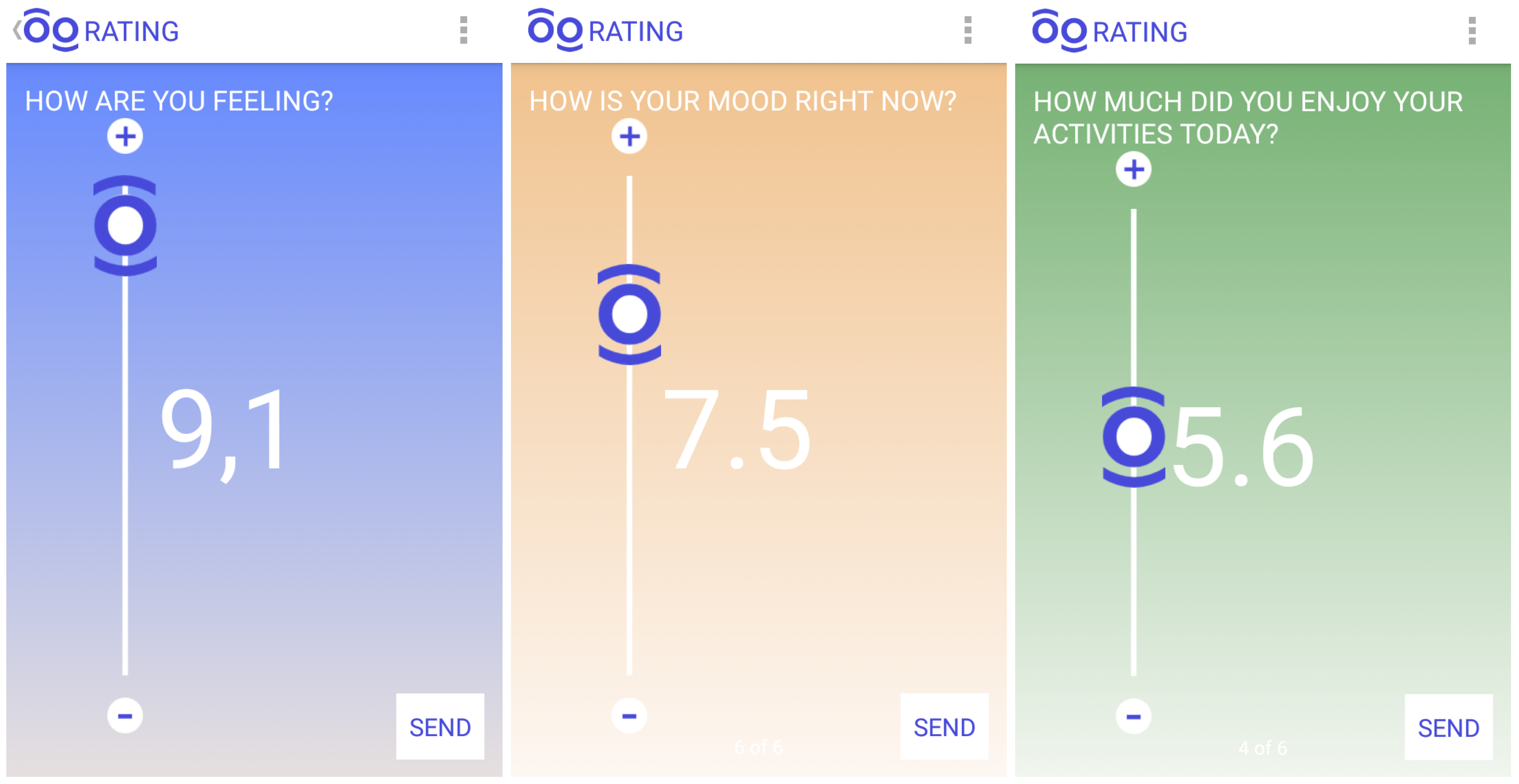
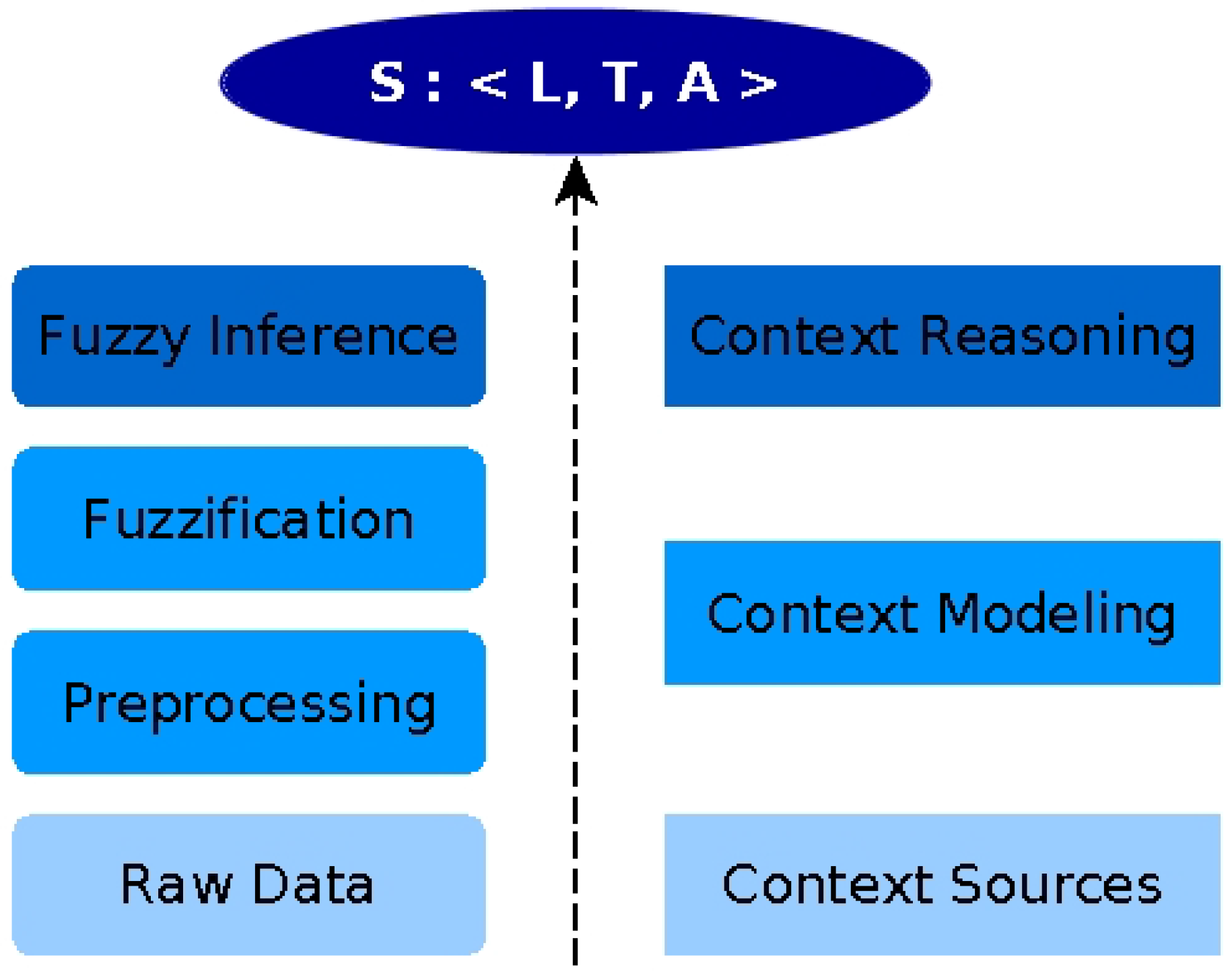


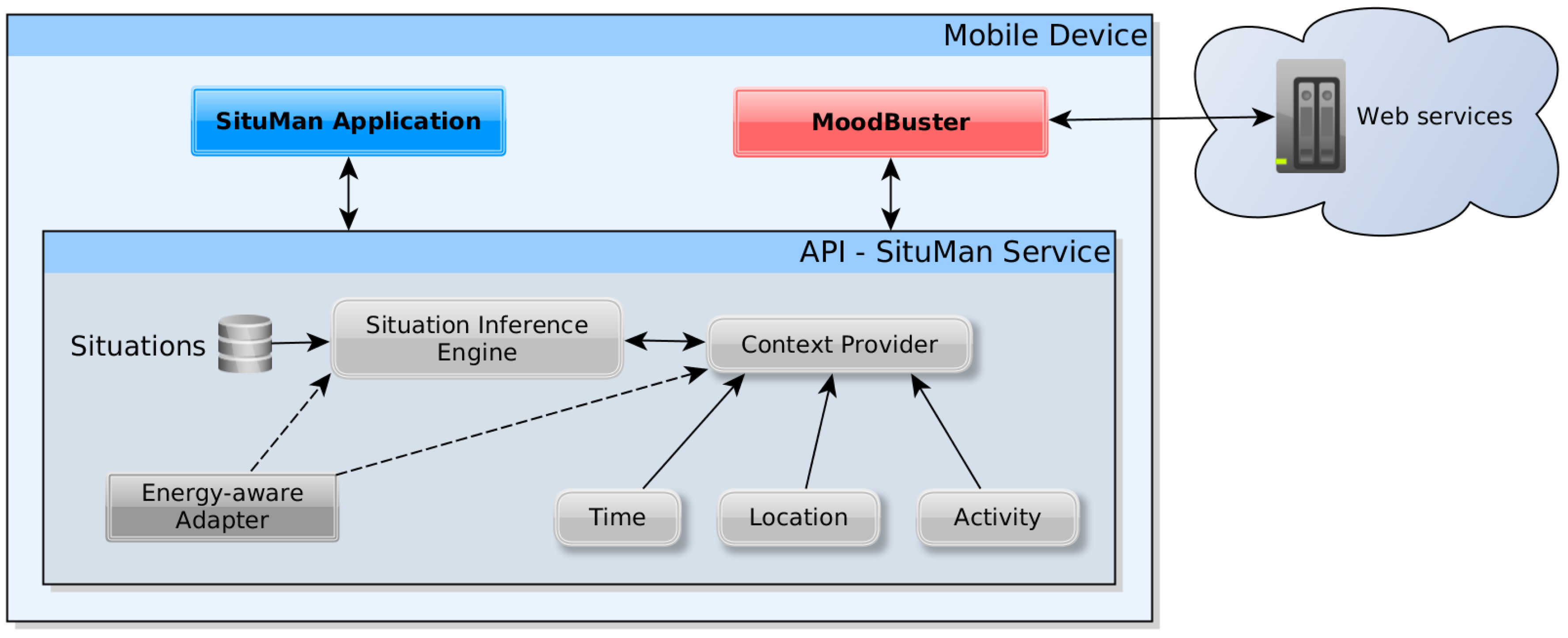
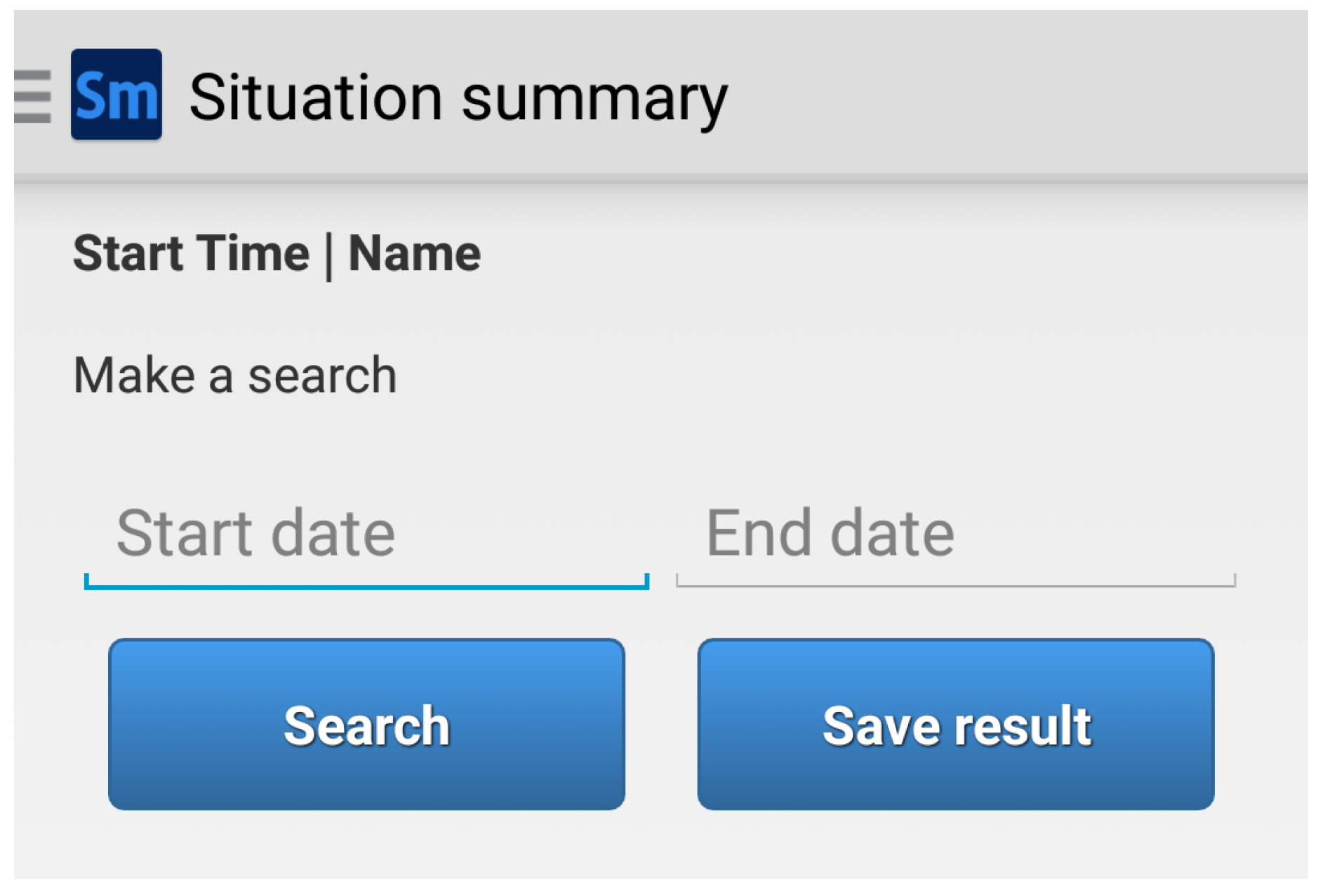

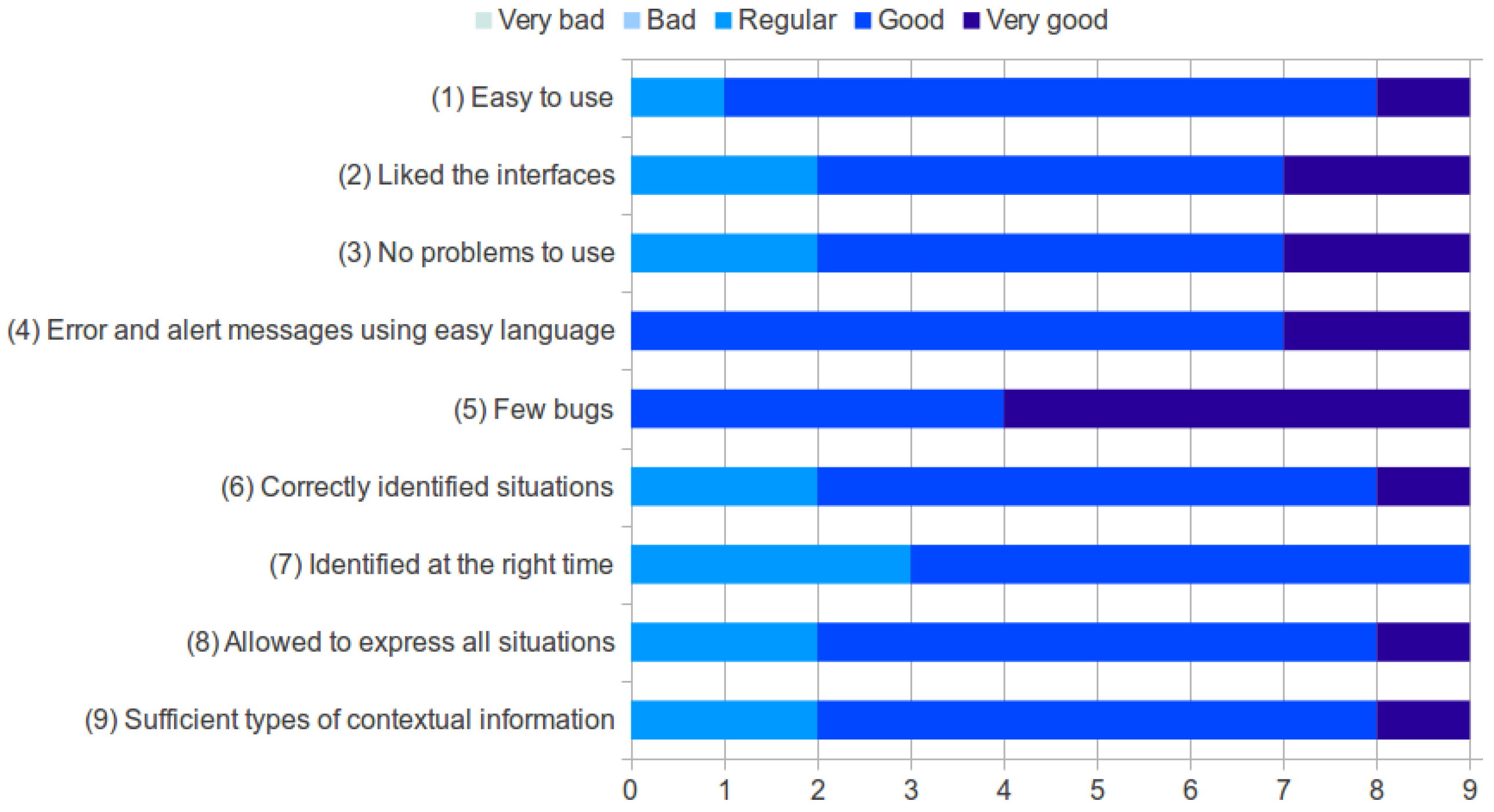
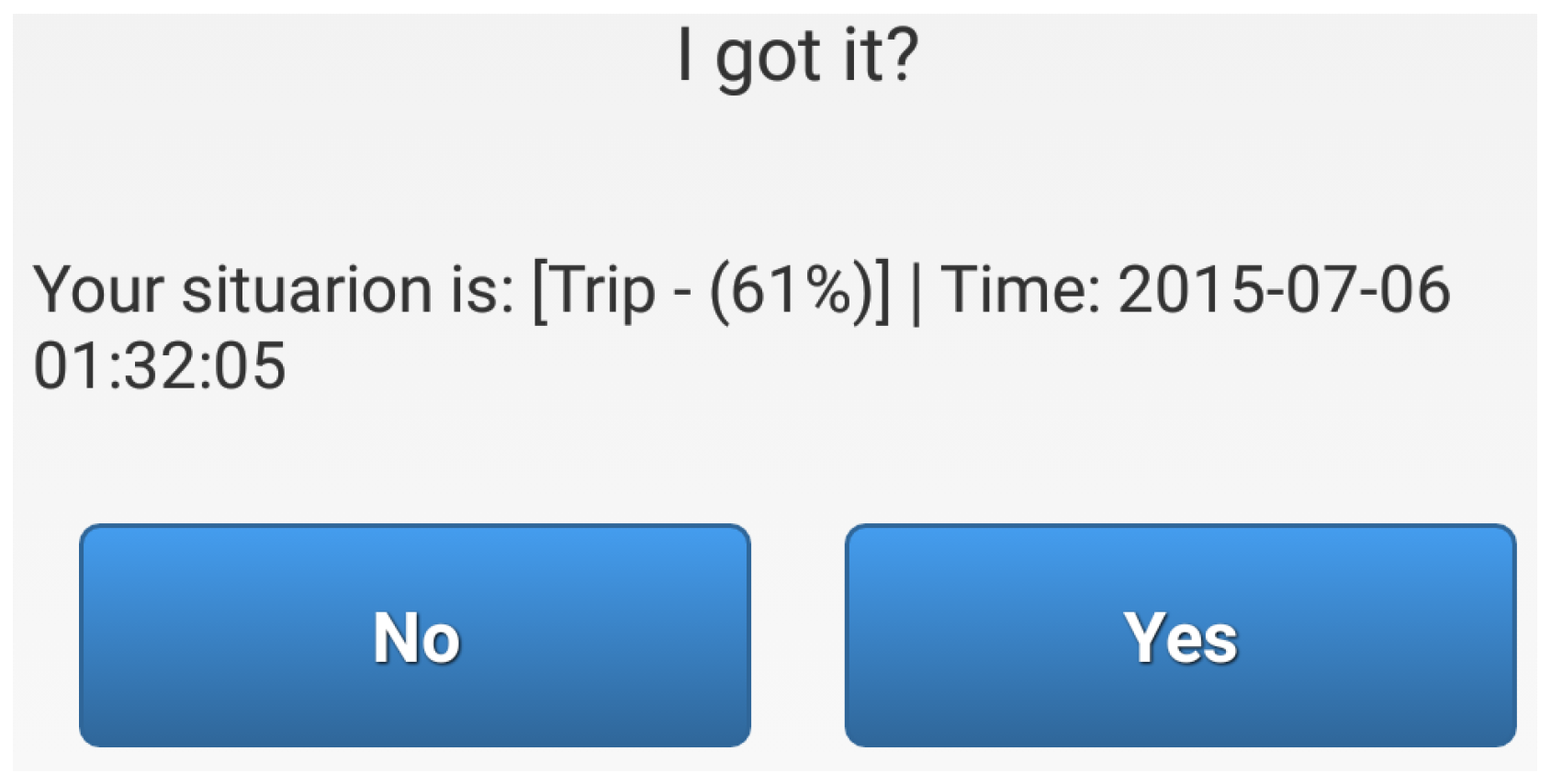
| Fuzzy Set | Membership Function |
|---|---|
| Night (Night1 ∪ Night2) | |
| Weekend (Weekend1 ∪ Weekend2) |
| Participant | Defined | Correct | Incorrect |
|---|---|---|---|
| 1 | 3 | 45 (100%) | 0 |
| 2 | 3 | 28 (≈90.32%) | 3 |
| 3 | 4 | 42 (100%) | 0 |
| 4 | 5 | 33 (≈86.84%) | 5 |
| 5 | 3 | 38 (≈90.47%) | 4 |
| 6 | 6 | 54 (100%) | 0 |
| 7 | 5 | 60 (≈86.95) | 9 |
| 8 | 5 | 73 (≈86.90) | 11 |
| 9 | 4 | 14 (≈77.77%) | 4 |
| 10 | 4 | 10 (≈90.90%) | 1 |
| 11 | 3 | 43 (≈97.72%) | 1 |
| 12 | 6 | 11 (≈91.66%) | 1 |
© 2017 by the authors; licensee MDPI, Basel, Switzerland. This article is an open access article distributed under the terms and conditions of the Creative Commons Attribution (CC-BY) license (http://creativecommons.org/licenses/by/4.0/).
Share and Cite
Soares Teles, A.; Rocha, A.; José da Silva e Silva, F.; Correia Lopes, J.; O’Sullivan, D.; Van de Ven, P.; Endler, M. Enriching Mental Health Mobile Assessment and Intervention with Situation Awareness. Sensors 2017, 17, 127. https://doi.org/10.3390/s17010127
Soares Teles A, Rocha A, José da Silva e Silva F, Correia Lopes J, O’Sullivan D, Van de Ven P, Endler M. Enriching Mental Health Mobile Assessment and Intervention with Situation Awareness. Sensors. 2017; 17(1):127. https://doi.org/10.3390/s17010127
Chicago/Turabian StyleSoares Teles, Ariel, Artur Rocha, Francisco José da Silva e Silva, João Correia Lopes, Donal O’Sullivan, Pepijn Van de Ven, and Markus Endler. 2017. "Enriching Mental Health Mobile Assessment and Intervention with Situation Awareness" Sensors 17, no. 1: 127. https://doi.org/10.3390/s17010127







